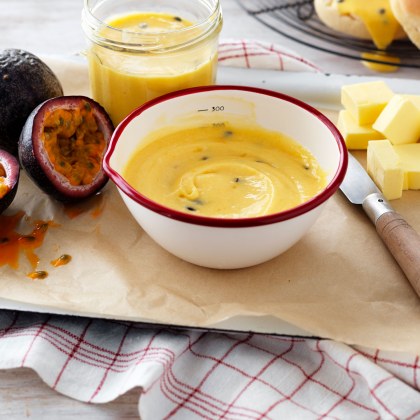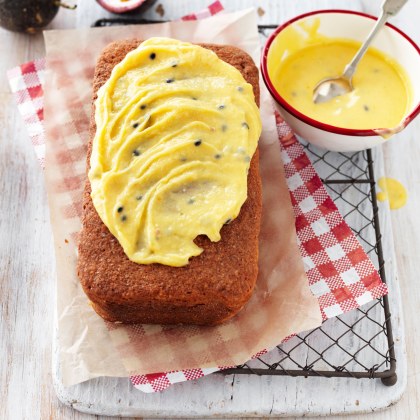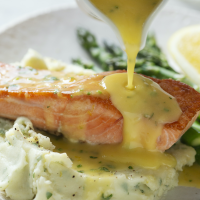How to make passionfruit butter (curd)
Passionfruit butter is a sweet curd that’s as simple to make as it is delicious. Follow this traditional recipe and extra guidelines to ensure your next batch is the best yet.
INGREDIENTS
- 4 whole eggs
- 2 egg yolks
- ¾ cup (160g) caster sugar
- ¾ cup (185ml) passionfruit pulp
- 2 tablespoons lemon juice
- 150g Western Star Chef’s Choice Butter, cold, cut into 1cm cubes
METHOD
- Combine eggs, sugar, passionfruit and lemon juice in a heatproof bowl over a saucepan of gently simmering water. Cook, stirring, for 3 minutes or until sugar has dissolved.
- Gradually add the butter, one or two cubes at a time, whisking continuously.
- Cook, whisking, for a further 5 minutes or until the mixture has thickened and coats the back of a spoon. Remove from heat. Cover the curd surface with plastic wrap to prevent it from forming a skin. Allow to cool to room temperature, then refrigerate until cold.
- Save the recipe to your myfoodbook cookbook: Passionfruit Butter
How to make passionfruit butter thicker or thinner
This recipe calls for four whole eggs and two egg yolks, which gives the passionfruit butter a thick, spreadable texture and vibrant yellow colour. The more eggs, the thicker the curd. Adding more yolks also makes the colour more vibrant and the gives a richer texture.
For an extra thick curd add another egg or egg yolk. For a thin and pourable passionfruit butter, only use one whole egg or two yolks.
Can you use canned passionfruit in passionfruit butter?
Yes, but fresh passionfruit is always the best option. It's more intense, and will give you that tangy flavour needed to cut through the richness of the butter and eggs. Buy extra passionfruit to ensure you don’t run short as the amount of pulp can vary dramatically from season to season.
If you can't find fresh passionfruit, you can use the canned variety. You might want to add more lemon juice for more acidity.
What butter is best to use in passionfruit butter?
A good quality unsalted butter is best to use in passionfruit butter, so you can easily control the level of salt and you get the best rich buttery flavour. Western Star Chef's Choice Butter is an award-winning unsalted cultured butter with an extra creamy flavour and texture. This butter will always give you a rich and fresh-tasting result, whether you're making passionfruit or lemon butter.
Can you remove the seeds from the passionfruit?
Use the juice and seeds as is or strain them through a fine sieve before making the curd to remove the seeds. You can return some seeds to the finished warm butter for visual appeal. For a smoother consistency, blend the pulp in a food processor. The end product will still retain some crunch from the seeds.
What does lemon juice do in passionfruit butter?
Lemon is a natural flavour enhancer that will liven up the taste of your passionfruit butter. Taste and adjust the amount of lemon juice in your butter. This is important as passionfruit acidity and sweetness will vary from season to season.
Can I add cornflour to this recipe?
Cornflour isn’t used in traditional curd recipes, but it can be useful to help thicken the curd and stabilise it, to reduce the change of it splitting. If you want to use cornflour, add it to the other ingredients in step one. To dissolve it completely, whisk it in with the juice. This mixture should still be cooked at low temperatures so as not to overcook the eggs.
At what temperature should you cook passionfruit butter?
The passionfruit butter mixture must not be heated over 76°C-80°C. This is the ideal range to set your eggs so they form a thick, smooth curd. Overheating above 85°C will result in a grainy textured curd upon cooling.
To control the heat, cook curd in a bowl over a pan of simmering water (double boiler). This will be a little slower but ensures the temperature remains stable. Overheating will result in a scrambled egg texture and flavour. If you are concerned that your curd may have reached too high a temperature, lower the base of your saucepan into a sink of cold water to stop the cooking process immediately while whisking continuously.
Do you really have to whisk the whole time?
Yes, if you stop whisking you risk overcooking the bottom of your curd which can result in lumps, graininess or an eggy flavour. Because you have to add the butter gradually, it can take up to 30 minutes to make a large batch of curd, so set aside some time just for making the curd and don't multitask - it's worth it for the end result!
How can you tell when the curd is fully cooked?
To check the curd is ready, dip a spoon in and run your finger along the back of the spoon. It should leave a clean line that holds for a moment, which means the curd is ready. Or you can spoon a small quantity of curd onto a cold plate. When the rim of the liquid does not separate around the edge of the butter, it is ready. The curd will continue to thicken as it cools completely.
How long will passionfruit curd keep?
Spoon into a container, cover and refrigerate. Keep your curd in an airtight container in the refrigerator for up to two weeks.
Can you freeze passionfruit curd?
Yes. To freeze, fill airtight containers in useable portions, making sure to leave a 1-2cm gap at the top. Cover the surface with cling wrap and cover with a lid. Label and date. Thaw curd by placing it in the refrigerator one day before you plan to use it. Stir and use from cold.
How to use passionfruit butter
Passionfruit butter is so versatile, here are 10 different ways to use it:
- Ice or fill a cake, like this Butter Cake with Passionfruit Butter
- Sandwich it between shortbreads as show in the video
- Dollop onto pavlova
- Pipe into choux pastries like profiteroles and eclairs
- Spread on toast or crumpets
- Stir through fruit salad
- Swirl through ice cream or Greek/plain yoghurt
- Layer in a trifle
- Use it to add flavour to cold vanilla custard or pudding
- Layer with muesli and yogurt to make breakfast cups















